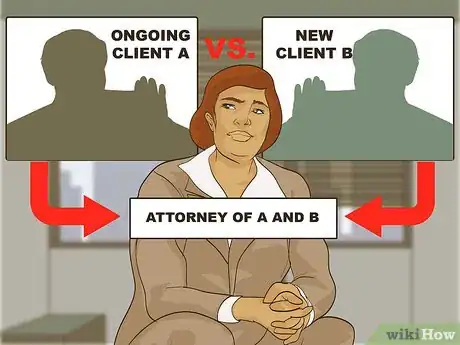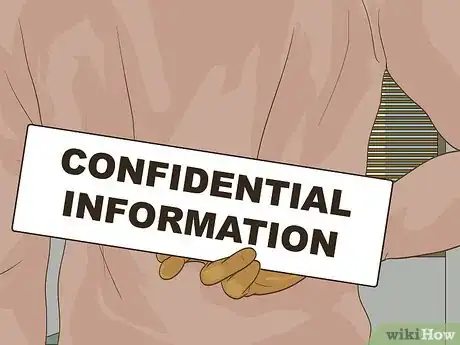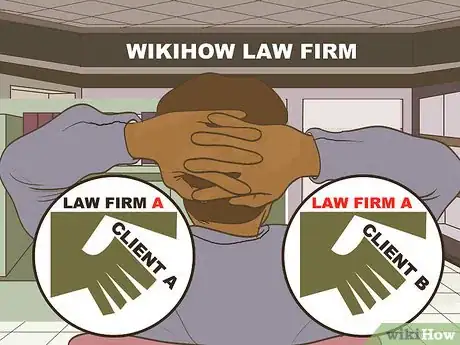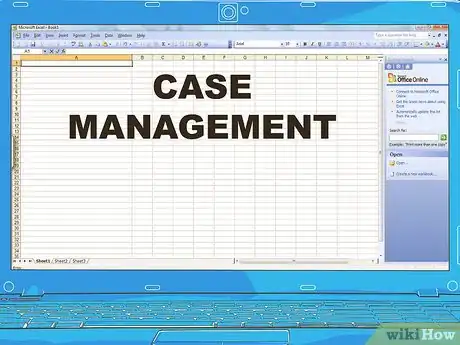This article was co-authored by Lahaina Araneta, JD. Lahaina Araneta, Esq. is an Immigration Attorney for Orange County, California with over 6 years of experience. She received her JD from Loyola Law School in 2012. In law school, she participated in the immigrant justice practicum and served as a volunteer with several nonprofit agencies.
There are 12 references cited in this article, which can be found at the bottom of the page.
This article has been viewed 36,842 times.
Ethical rules limit who attorneys may represent. To make sure you don’t run afoul of these rules, you must do a “conflicts check” before signing a new client. Generally, a conflict check consists of checking whether a new client is adverse to other clients you have represented, past and present. If they are, you must analyze whether you can still ethically represent the new client. Law firms use different types of databases to store their client information, so you should choose one that works best for you.
Note: This article discusses the ABA’s Model Rules of Professional Conduct. Almost all U.S. states have adopted these rules.[1] However, variations might exist even when adopted. Always make sure you understand your state's rules.
Steps
Checking for Conflicts with Current Clients
-
1Identify if a current client is on the other side. Whenever someone comes to your law firm with a problem, you should identify who are the opposing parties and their associates. It may be a current client. If so, a conflict could exist. Rule 1.7 covers this scenario.[2]
- Remember that clients can be adverse even in non-litigation contexts, so don’t assume you can avoid checking for conflicts because you are a transactional lawyer.
-
2Analyze whether the clients are adverse. A conflict exists if the parties are adverse. The most common conflict of interest involves a new client who wants to sue one of your current clients. Here, the clients are clearly adverse to each other so there is a conflict.
- For example, you represent A in ongoing employment litigation. Your new client, B, wants to sue A for pollution. Here, the clients are adverse to each other. Each client probably wonders whether you can fully represent their interests.
- An attorney can compromise their client's interest by adding or not revealing information held by the attorney because it is protected by the attorney-client privilege.
- Clients can be adverse in transactional matters as well. For example, you might represent Company X, which is being bought by Company Y. However, you might represent Company Y in other matters. Here a conflict exists, and you’ll need written informed consent from both X and Y.[3]
Advertisement -
3Ask if you will be “materially limited” in your representation. Sometimes, you can’t represent a client if you will be materially limited in your representation. If so, a conflict exists. Here are some common scenarios where a material limitation arises:
- You are asked to represent every member of a potential business partnership. Here, you are probably limited because you cannot aggressively advocate one person’s position, since doing so will limit your ability to advocate for the other members of the joint venture.[4] A conflict exists between current clients.
- Another example is opposing counsel is represented by a lawyer who is related to you.
-
4Identify if you can cure the conflict. Even if there is a conflict, you can possibly still represent the new client. However, you must reasonably believe you can provide competent, vigorous representation to both clients. If you can't, you must turn down the new client.
- Also, all sides must give informed, written consent. Make sure you obtain this consent before beginning the representation of the new client. The consent must be extremely detailed and illustrate what the representation entails and with whom on both sides.
- There is an exception to the consent rule. You cannot represent two sides if one makes a claim against the other in the same litigation.[5] For example, you cannot represent both the employer and an employee in the same workplace sexual harassment case.
Checking for Conflicts with Former Clients
-
1Identify if the new client is adverse to a former client. Conflicts also arise when you seek to represent a new client whose interests are adverse to a former client. Model Rule 1.9 covers this scenario. Even though you no longer represent former clients, you must maintain the attorney client privilege, which can limit your representation. Ask the new client to identify who is on the other side of their dispute and check if they are former clients.
- Clients are most clearly adverse when they are suing each other.
- However, they may also be adverse in transactional matters. For example, if someone is negotiating a contract with an employer, ask who the employer is. It may be a former client.
-
2Confirm the “former client” isn’t a current client. Different rules apply to current clients and former clients, so confirm that you have finished your representation of the “former client.” If you haven’t, then they are a current client and you need to analyze whether you can represent them according to the information above.
- A client is a former client when you have completed all work and issued a letter to the client closing the matter.
- If you haven’t issued a closing letter, analyze why. Is it because you still potentially have work to perform for the client? Is it because you forgot to send the letter? You may need to send a letter to clarify the relationship is at an end.
- If you have regularly performed work for a client over a long time, then they may still be a current client even if you haven't done any work recently.[6] You should analyze the situation with a lawyer who specializes in professional responsibility. You can also call your state bar association's ethics hotlines to get a free opinion.
-
3Check if the matters are related. You can’t represent a new client in the same or a "substantially similar" matter where their interests are materially adverse to a former client.[7] Ask the new client why they need your services and compare this dispute to the matter you worked on for the former client.
- Matters are “substantially related” when they involve the same legal dispute or transaction.
- For example, clients are adverse where you helped former client A draft a retirement policy for its employees. Now one of the employees, client B, has come to you and wants to challenge the legality of the retirement policy. This dispute involves substantially the same matter, so there is a conflict.
-
4Ask if you have confidential information about the client. Matters are also “substantially related” where you are at substantial risk of using confidential information obtained from the former client to the benefit of your new client.[8] If so, there is a conflict.
- However, matters may be unrelated. For example, you might have represented former client A in a real estate closing. Now, new client B wants to sue Client A for personal injuries caused by an automobile accident. These matters are unrelated, and you are not likely to use confidential information gleaned in the real estate closing to client B’s advantage in the personal injury lawsuit. Thus, you may be able to represent this client without a conflict of interest.
-
5Identify the law firm representing the opponent. You can’t represent a new client in the same or a substantially related matter if you worked for the law firm that represents the opponent and you acquired confidential information.[9]
- For example, you might have worked for a law firm that represents a chemical manufacturer in a personal injury class action. Now a potential client at your new law firm wants to sue the manufacturer for personal injury. There is a conflict here if you obtained confidential information about the chemical manufacturer at your former firm. Thus, you would be violating teh attorney client privilege if you used this knowledge at all in your representation.
- Remember that Rule 1.9 conflicts are imputed to all members of the firm.[10] For example, say you hired a new junior associate who represented the opponent at a prior law firm. She must be screened per Rule 1.10, otherwise everyone in the firm is conflicted out.
-
6Obtain informed consent, if necessary. You can cure a conflict with a former client if you get their informed consent. The consent must be in writing.[11]
- You should also get written consent from the new client, since your former representation may materially limit your ability to represent them.
Identifying Personal Conflicts
-
1Recognize standard personal conflicts. Sometimes you might have a personal conflict that can materially limit your representation of a client. If so, you must decline the representation. There are some standard personal conflicts you can easily recognize:
- You are seeking a job with the law firm that represents the opponent.[12] Here there is a conflict.
- You are drafting a will or trust under which you will receive a substantial gift. A conflict exists unless you are related to the person.
- You accept payment from someone other than the client. You can cure this with informed consent from the client.
-
2Analyze whether you will make inconsistent arguments. Lawyers are generally free to represent who they want. For example, you can represent a victim of workplace sexual harassment and also represent employers accused of sexual harassment. Although some lawyers represent clients on only one side of disputes, you are free to represent either side. However, a potential conflict could exist when you make inconsistent arguments in different cases. You should be alert to this at the conflicts check stage.
- For example, you might represent a bank in a lawsuit involving whether certain late penalties are legal under state law. A person comes to your firm wanting to sue a different bank over its late penalties. If you win the lawsuit representing the bank, you could create legal precedent that works against your other client.
- The Model Rules list several factors to consider, including whether the precedent will “seriously weaken” your other client’s case.[13] However, any inconsistent position should be treated as a potential conflict, just to be safe.
-
3Continually assess whether personal conflicts have arisen. Many personal conflicts arise only after you start representing the client. Accordingly, you won’t catch these conflicts with a conflicts check. Nevertheless, you have an ethical duty to avoid conflicts throughout your entire representation. Some of the more common personal conflicts that can arise include:[14]
- You want to enter a business transaction with a client or obtain a pecuniary interest that is adverse to a client. You can only do so if the terms are fair and reasonable and you notify the client in writing. You must get informed written consent from the client, and you should also advise them to seek independent legal advice.
- You want to provide financial assistance to a client in connection with possible or existing litigation. Although you can advance court costs and other expenses as part of a contingency fee agreement, you can’t financially support a client.
- You have a sexual relationship with a client that started after the representation. This may be prohibited depending upon the state.
- You try to get a proprietary interest in litigation apart from an authorized lien or reasonable contingency fee. This is prohibited.
Maintaining a Database
-
1Have clients fill out in-take forms. Your conflicts check system is only as good as the information you enter into it. Accordingly, you should gather all relevant information from clients and potential clients. Have them fill out an in-take form and remember to update it as the case unfolds. An in-take form should request the following:[15]
- name of the client and any entities related to the client (such as their employer or business that they own)
- contact information for the client and related entities
- nature of the representation (why they need legal help)
- name of the person authorizing the agreement
- terms and conditions of your representation
- name, address, and contact numbers for all parties involved in the representation, including witnesses and experts
-
2Use case management software. You can type up a list of your client information in Excel and check it as part of your conflicts check. However, the best case management software will allow you to perform thorough conflicts checks quickly.
- You will keep detailed information about your clients in the system, including the names of opposing counsel, witnesses, interested parties, etc. You can then search this information for any name or term that you want.
-
3Check your database before the initial consultation. You should perform a conflicts check before meeting with a client for a consultation.[16] Have your secretary gather basic information from the person, such as their identity and who they are adverse to. Perform a check to see if they are adverse to current or former clients, or if there is a potential personal conflict.
- You should certainly perform a conflicts check before the client signs an engagement letter or a retainer agreement.
- By checking early, you can prevent the potential client from divulging confidential information to you and potentially causing a greater ethical problem.
-
4Continue to check for potential conflicts. Conflicts can arise at any point, and your firm should perform rolling conflicts checks at various points, even after you have begun the representation. Perform another check at the following milestones:[17]
- Before opening a new matter for an existing client.
- When a new attorney, party, or witness enters the litigation.
-
5Check your database before hiring a lawyer. You also need to obtain a full list of client matters from any lawyer you hire. Obtain this information when you decide to interview an attorney and run a conflicts check before hiring.[18]
- Remember that Rule 1.10 provides ways for screening conflicted attorneys so that your firm won’t have a conflict. However, you need to know potential conflicts early so that you can take adequate measures.
- If you are unsure of how to properly screen a lawyer, contact an attorney who specializes in professional responsibility.
Expert Q&A
-
QuestionI am suing my employer in both federal and state using different law firms. My employer is using the exact same law firm to defend both the state and federal case. Is this a conflict on interest?
 Lahaina Araneta, JDLahaina Araneta, Esq. is an Immigration Attorney for Orange County, California with over 6 years of experience. She received her JD from Loyola Law School in 2012. In law school, she participated in the immigrant justice practicum and served as a volunteer with several nonprofit agencies.
Lahaina Araneta, JDLahaina Araneta, Esq. is an Immigration Attorney for Orange County, California with over 6 years of experience. She received her JD from Loyola Law School in 2012. In law school, she participated in the immigrant justice practicum and served as a volunteer with several nonprofit agencies.
Attorney at Law No this is not. Your two cases can be managed by separate attorneys and firms. Their two cases (federal and state) can be managed by the same firm.
No this is not. Your two cases can be managed by separate attorneys and firms. Their two cases (federal and state) can be managed by the same firm.
Warnings
- Six states have adopted the ABA Model Rules of Professional Conduct. California has their own rules, but has adopted the comments.[19]⧼thumbs_response⧽
References
- ↑ http://www.americanbar.org/groups/professional_responsibility/publications/model_rules_of_professional_conduct/alpha_list_state_adopting_model_rules.html
- ↑ http://www.americanbar.org/groups/professional_responsibility/publications/model_rules_of_professional_conduct/rule_1_7_conflict_of_interest_current_clients.html
- ↑ http://www.americanbar.org/groups/professional_responsibility/publications/model_rules_of_professional_conduct/rule_1_7_conflict_of_interest_current_clients/comment_on_rule_1_7.html
- ↑ http://www.americanbar.org/groups/professional_responsibility/publications/model_rules_of_professional_conduct/rule_1_7_conflict_of_interest_current_clients/comment_on_rule_1_7.html
- ↑ http://www.americanbar.org/groups/professional_responsibility/publications/model_rules_of_professional_conduct/rule_1_7_conflict_of_interest_current_clients/comment_on_rule_1_7.html
- ↑ http://lprb.mncourts.gov/articles/Articles/When%20Does%20a%20Current%20Client%20Become%20a%20Former%20Client.pdf
- ↑ http://www.americanbar.org/groups/professional_responsibility/publications/model_rules_of_professional_conduct/rule_1_9_duties_of_former_clients.html
- ↑ http://www.americanbar.org/groups/professional_responsibility/publications/model_rules_of_professional_conduct/rule_1_9_duties_of_former_clients/comment_on_rule_1_9.html
- ↑ http://www.americanbar.org/groups/professional_responsibility/publications/model_rules_of_professional_conduct/rule_1_9_duties_of_former_clients.html
- ↑ http://www.americanbar.org/groups/professional_responsibility/publications/model_rules_of_professional_conduct/rule_1_10_imputation_of_conflicts_of_interest_general_rule.html
- ↑ http://www.americanbar.org/groups/professional_responsibility/publications/model_rules_of_professional_conduct/rule_1_9_duties_of_former_clients.html
- ↑ http://www.americanbar.org/groups/professional_responsibility/publications/model_rules_of_professional_conduct/rule_1_7_conflict_of_interest_current_clients/comment_on_rule_1_7.html
- ↑ http://www.americanbar.org/groups/professional_responsibility/publications/model_rules_of_professional_conduct/rule_1_7_conflict_of_interest_current_clients/comment_on_rule_1_7.html
- ↑ http://www.americanbar.org/groups/professional_responsibility/publications/model_rules_of_professional_conduct/rule_1_8_current_clients_specific_rules.html
- ↑ http://www.americanbar.org/publications/law_practice_magazine/2013/november-december/ethics.html
- ↑ http://www.americanbar.org/publications/law_practice_magazine/2013/november-december/ethics.html
- ↑ http://www.americanbar.org/publications/law_practice_magazine/2013/november-december/ethics.html
- ↑ http://www.americanbar.org/publications/law_practice_magazine/2013/november-december/ethics.html
- ↑ http://www.americanbar.org/groups/professional_responsibility/publications/model_rules_of_professional_conduct/alpha_list_state_adopting_model_rules.html













































































